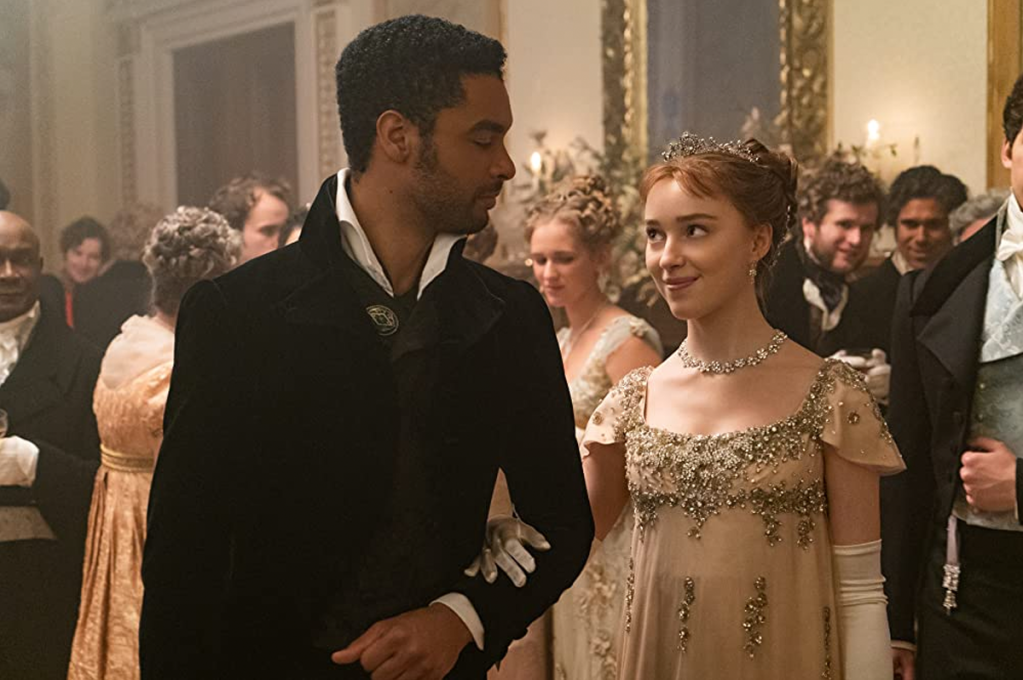Bridgerton (Netflix) is just about the worst period drama I’ve seen on television, but I’ve yet to read a single review which tells it like it is. Why could that be, I wonder? Well, here’s my theory: I think it’s because this wooden, poorly scripted, horrifically set- and costume-designed, anachronistic, clunky, cringe-inducing farrago of sub-sub-sub-Jane Austen tosh has inoculated itself against criticism by deciding that about a third of the characters in the London of 1813 should be black.
We’re not just talking servants and the occasional writer like Olaudah Equinao, which would have been historically accurate. We’re talking proper toffs: even the main love interest, the brooding, Mr Darcy-like Duke of Hastings is played by mixed-race Regé-Jean Page. In fact, blackness goes right to the very top: Queen Charlotte is played by Golda Rosheuvel, whose skin is sufficiently coffee-colored to have prompted the question in several feature articles ‘Was Queen Charlotte Black?’
Short answer: no. This idea, floated by an obscure historian with an ax to grind, is based on Charlotte of Mecklenburg-Strelitz’s descent from the ‘black’ branch of the Portuguese royal family, originating in the 13th-century relationship between Alfonso III and his lover Madragana, a Moor. Queen Charlotte was black in the same way that I am heir to the British throne, because I am descended from Edward III. The only wrinkle with this is that so is everyone of British descent. Every Briton according to geneticists is descended between 21 and 24 generations from Edward III. Really, though, so what?
See how race does the exact opposite of what showrunner Shonda Rhimes probably intended when she decided to inflict modish ‘colorblind’ casting on Julia Quinn’s innocent potboiler novels? Instead of not noticing, as Rhimes presumably hoped, we instead find ourselves noticing to the exclusion of all else. Not all of us, perhaps. Just those of us with our critical and historical faculties intact enough to ask awkward questions like ‘How exactly was it that a society much more stratified and class-conscious than our own managed to be so woke on race that not a single person notices, even en passant, whether a character is black or white?’
Last year, Julian Fellowes assayed a metropolitan follow up to Downton Abbey set in 1840s London, Belgravia. It was a little too eager to explain the English class system and the period to American audiences, resulting in too much ‘tell not show’ and slabs of historical exegesis ripped from Wikipedia:
Lady Brockenhurst: ‘The great Thomas Cubitt? I assume he was no longer a ship’s carpenter at that time?’
Anne Trenchard: ‘You’re right. He started as a carpenter… He devised a new method for building and took in employ all the different trades involved — bricklayers, plasterers — so the people he worked for had only to give the commission. He and his brother saw to everything.’
At least Fellowes made a stab at authenticity. Bridgerton is just clueless. There’s a scene, for example, where an upper-class character called Colin — was anyone posh called Colin in those days? — announces that he’s starting his Grand Tour in Greece. Why? How? Grand Tours (the cultural trip through Europe enjoyed by scions of the aristocracy) began with a trip across the Channel to Belgium or France, then progressed via Switzerland to Rome, possibly getting as far as Naples or Sicily, but almost never Greece until well after Greek independence in 1821. OK, I looked this up on the internet. But couldn’t the scriptwriters?
The storyline, meanwhile, is Jane Austen with all the plot and nuance and character sophistication removed, with just the balls left in: endless pretty young things in horribly overbright, technicolor crinoline, observed by matronly chaperones and snooty dowagers, approached by handsome young bucks for smoldering flirtation scenes, and by rich but ugly and awkward suitors for embarrassing rejection scenes. There’s also — for the laydeez, presumably: they’re so much more into filth than we chaps are — a lot more explicit sex. And, so I gather, later in the series, though thank goodness I’ll never get that far, a graphic male rape. Also, apparently, there’s a scene where the main female love interest Daphne Bridgerton (Phoebe Dynevor) is so passionate in her lovemaking to her husband the Duke that she refuses to stop even when he begs her to.
The people who choose to sit through this dreadful tripe thoroughly deserve every grim, life-wasting moment of it. After one toe-curling episode, I’m calling for my carriage.
This article was originally published in The Spectator’s February 2021 US edition.

























